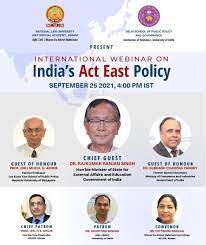A Webinar On Act East Policy:

A webinar was recently organised on “Act East Policy”.
- India’s ‘Act East’ policy is a diplomatic initiative to promote economic, strategic and cultural relations with the vast Asia-Pacific region at different levels.
- It is considered as the modern version of the ‘Look East Policy’ which was launched in 1991 by then Prime Minister V. Narasimha Rao.
- The main focus of ‘Look East Policy’ was to shift the country’s trading focus from the west and neighbors to the booming South East Asian countries.
- The “Act East Policy” was launched at the East Asia Summit in Myanmar in November 2014.
- Under the “Act East Policy” the government is relying on the 3 C’s (Culture, Connectivity, and Commerce) to develop better relations with ASEAN nations.
- The focus of the “Look East Policy ” was to increase economic integration with the South East Asian countries and the area was confined to SouthEast Asia only.
- On the other hand the focus of the “Act East Policy” is economic and security integration and the focus area increased to South East Asia as well as East Asia.
Objectives of ‘Act East Policy’:
- Promote economic cooperation, cultural ties, and develop a strategic relationship with countries in the Asia-Pacific region through continuous engagement at regional, bilateral, and multilateral levels.
- To increase the interaction of the North-Eastern Indian states with other neighboring countries.
- To find out the alternatives of the traditional business partners like; more focus on the Pacific countries in addition to the South East Asian countries.
- To curb the increasing impact of China in the ASEAN region.
- Experts say that under the “Act East Policy” the government is relying on the 3 C’s (Culture, Connectivity, and Commerce) to develop better relations with ASEAN nations.
- Under the Act East Policy (AEP), the India-Japan strategic partnership has been lifted to an entirely new level, underscoring the importance of Indo- Pacific cooperation.
- India believes in an Indo-Pacific that is free, open and inclusive, and one that is founded upon a cooperative and collaborative rules-based order.
- ASEAN’s centrality remains the abiding contemporary characteristic of the Indo-Pacific at the regional level.
- India has placed the ‘Indo-Pacific’ at the heart of its engagement with the countries of South, Southeast and East Asia. Gradually, Act ‘East’ is getting transformed into Act ‘Indo-Pacific’.




